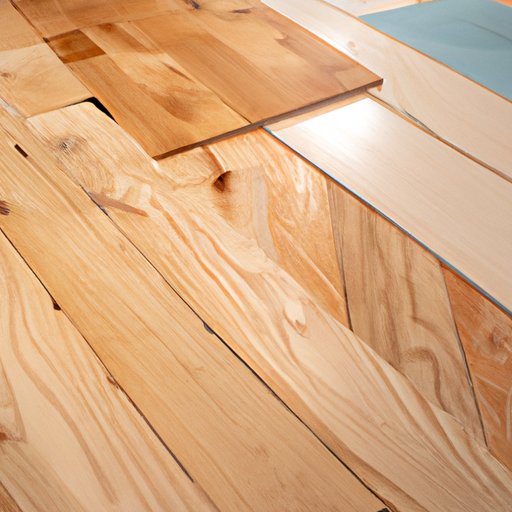
I. Introduction
Hardwood floors are a beautiful addition to any home, but over time, they can become dull or damaged. Refinishing your hardwood floors is an excellent way to bring them back to life! This article will guide you through the process of refinishing your hardwood floors, including the tools and materials needed, step-by-step instructions, tips and tricks, and troubleshooting common problems.
II. Step-by-Step Guide to Refinishing Hardwood Floors
The first step in refinishing hardwood floors is to gather the necessary tools and materials. You will need a drum or belt sander, a sanding block, sandpaper in various grits, a shop vac, stain, a finish, and a roller or paintbrush.
Once you have all the materials, follow these steps:
1. Removing old finishes: Use a paint stripper to remove any old finishes on the floor. This is an essential step before sanding.
2. Sanding: Use the drum or belt sander to sand the floor. Start with a coarse grit sandpaper and work your way up to a fine grit. This will help create a smooth, even surface.
3. Staining: Once the floor is sanded, it’s time to apply the stain. Choose a color that complements your home’s decor. You can apply the stain with a roller or a paintbrush.
4. Finishing: The final step is to apply the finish. Use a lamb’s wool applicator or a roller to apply the finish to the floor. Start in the farthest corner of the room and work your way towards the door.
Throughout the process, use a shop vac to clean up any dust or debris.
Here are some tips to make the job easier:
- Make sure the room is well-ventilated.
- Sand in the direction of the wood grain.
- Don’t rush the process—take your time to ensure the best results.
- Keep a buffer zone around the room to avoid accidental damage to baseboards or walls.
III. DIY vs. Professional Refinishing
When it comes to refinishing hardwood floors, there are two options: DIY or professional. Here are the pros and cons of each:
DIY Refinishing
- Pros: More cost-effective, allows for creative control over the finished product, can be done on your own time.
- Cons: Requires more time and effort, tools and materials must be rented or purchased, potential for errors if not experienced.
Professional Refinishing
- Pros: Experienced professionals handle everything, may be less time-consuming, no need to purchase or rent tools and materials.
- Cons: More expensive upfront, may not have complete creative control, must work with the company’s schedule.
Ultimately, the decision to DIY or hire a professional comes down to the homeowner’s preference and budget.
IV. Eco-Friendly Options
Traditional refinishing methods can be harmful to the environment. Fortunately, there are several eco-friendly options available:
- Water-based finishes: These finishes are low in VOCs and dry quickly.
- Natural oil-based finishes: These finishes are made from plant-based oils and are less toxic than traditional finishes.
- Natural waxes: These waxes are made from beeswax or carnauba and are an excellent natural alternative to traditional finishes.
While they may take longer to dry or be more expensive than traditional products, eco-friendly refinishing options are safer for you and the environment.
V. Refinishing Different Types of Hardwood
Not all hardwood floors are created equal. Here are the different types of hardwood and refinishing techniques:
- Red oak: Red oak is porous and takes stain well. However, sanding must be done carefully to avoid over-sanding and creating uneven spots.
- White oak: White oak has a more closed grain than red oak and is more resistant to scratches. It can be stained easily, but it’s essential to ensure the wood is clean and dust-free before refinishing
- Maple: Maple has a smooth, tight grain and is difficult to stain. It’s best to use a non-colored finish instead of staining.
When refinishing different types of hardwood, it’s important to research the specific techniques required to ensure the best results.
VI. Troubleshooting Refinishing Problems
Refinishing hardwood floors is a challenging task, and issues can arise. Here are some common refinishing problems and solutions:
- Staining too dark: Apply more coats of a lighter stain to balance the color.
- Dust or debris in the finish: Wait for the finish to dry, then sand the affected areas and apply another coat.
- Uneven finish: Sand down the uneven areas and reapply the finish.
Preventative measures can also be taken to avoid common refinishing problems. These include ensuring the wood is clean and dust-free before staining, correctly applying the stain and finish, and allowing ample drying time in between coats.
VII. Conclusion
Refinishing hardwood floors can be a daunting task, but with the proper tools and knowledge, it’s a DIY project that any homeowner can tackle! Remember to gather the necessary materials, follow each step carefully, and take your time to ensure a perfect finish. By taking the time to refinish your hardwood floors, you can enjoy the beauty and warmth of your home’s natural flooring for years to come.




